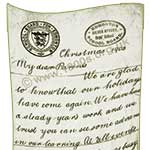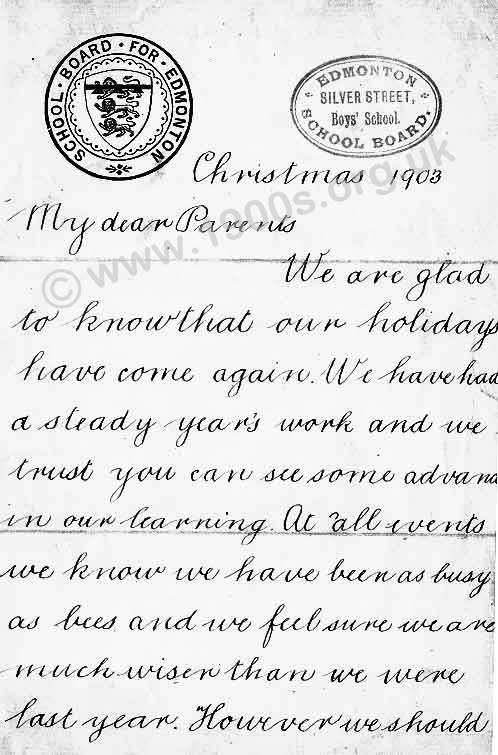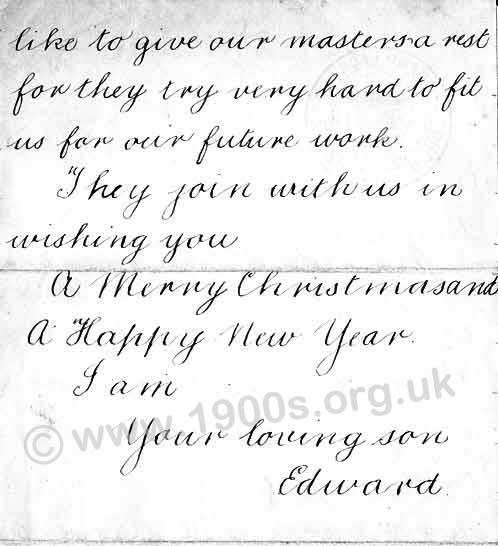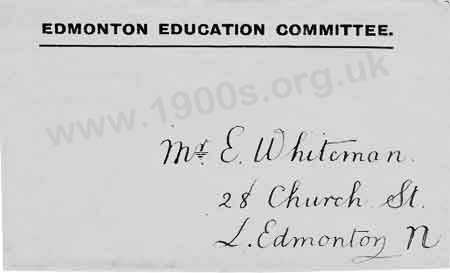The Christmas letter home from school, 1903

A boy's 1903 Christmas letter home reveals a great deal about what ordinary people's lives and expectations were like then. This page teases explores and discusses.
____
By the webmaster based on an original 1903 document
This page is about what can be gleaned from a child's Christmas letter home in December 1903. On another page is a 1915 Christmas letter home from a boy at Silver Street School which is worth comparing with this one. I felt that its main purposes seemed to be to encourage parents to canvass for their children's teachers to be freed from being conscripted into the armed forces during the First World War.
Whereas two letters twelve years apart hardly make a tradition, it does seem likely that a Christmas or end of term letter home was probably normal and that it was equally normal to include something complimentary about the teachers - known as masters.
The 1903 letter
The text of the letter is as follows. Images of the actual letter are below and magnify by pinching out.
Christmas 1903
My dear Parents
We are glad to know that our holidays have come again. We have had a steady year’s work and we trust you can see some advancement in our learning. At all events, we know we have been as busy as bees and we feel sure we are much wiser than we were last year. However we should lie to give our masters a rest for they try very hard to fit us for our future work.
They join with us in wishing you a Merry Christmas and a Happy New Year.
I am Your loving son,
Edward

Page 1 of a Christmas letter home from school, 1903.

Page 2 of the Christmas letter home from school, 1903, courtesy of David Smith
Letter courtesy of David Smith. Note that the first page is stamped as from the School Board which records show ceased to exist in 1902.
Norms of the time gleaned from the letter
The letter was probably copied from the blackboard which is all the more likely as it refers to 'we', the pupils, rather than 'I' as the individual. It does not give any hint as to the age of the Edward who wrote it, but, whatever his age, his writing cannot be faulted. His parents must have been impressed. He would certainly have been younger than 14, as the children left school then. The letter shows the style of the writing script that was normal at the time and expected of everyone irrespective of their social class.
The letter speaks of the boys' future employment, whereas today we would use a wider term to embrace university or management.
It is worth noting though that this letter, like the 1915 one finds a place for praising the teachers, who, as was normal at the time, were referred to as 'masters'.
Somewhat surprisingly, in my view, the pupils were provided with headed notepaper from the School Board for Edmonton. It would have been expensive with replacement sheets if any of the boys had made mistakes, but possibly the headed notepaper was regarded as waste as the School Board had ceased to exist. At the top right appears to be a rubber stamp, presumably to show that the letter had been checked as suitable for going out.
The 1903 envelope
Even the envelope provides information about life at the time:

Envelope of a Christmas letter home from school, 1903, courtesy
of David Smith.
It is interesting that the headed top reads Edmonton
Education Committee rather than the School Board
Note that the envelope is addressed to 'Mr' even though the letter is addressed to 'Dear Parents' (plural). It was accepted at the time that women were inferior to men. So it would have been unheard of to imagine that the letter would have been addressed to anyone other than the man of the house.
Note also the postcode. Postcodes have become much more complex over the years. In Edmonton in 1903, the postcode was just N standing for North London; while I was growing up in the 1940s it was N18. I don't know what it is now but it is almost certainly six characters or more.
There was no stamp on the envelope which means that the boys were trusted to hand over their letters to their parents - not that there was any reason why they shouldn't other than cultural norms.
| sources | webmaster | contact |
Text and images are copyright
If you can add anything to this page or provide a photo, please contact me.



